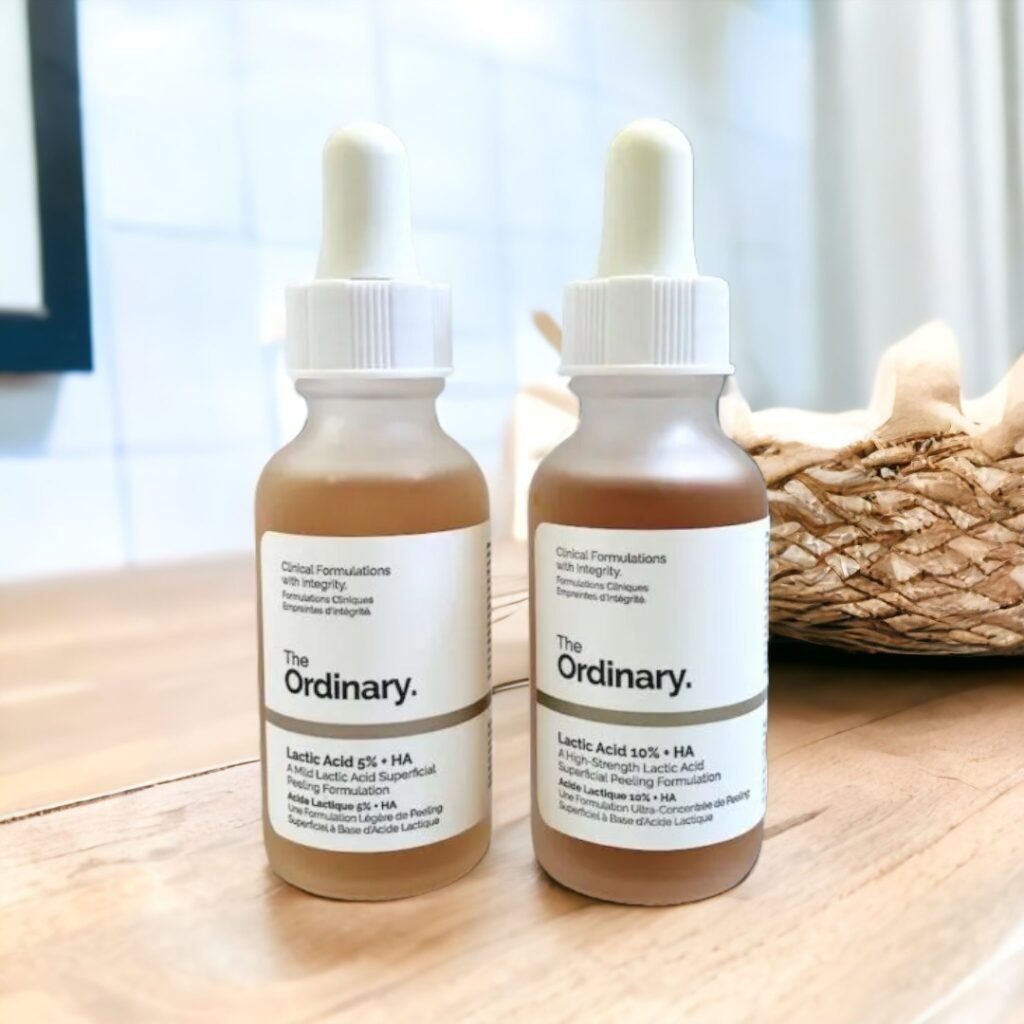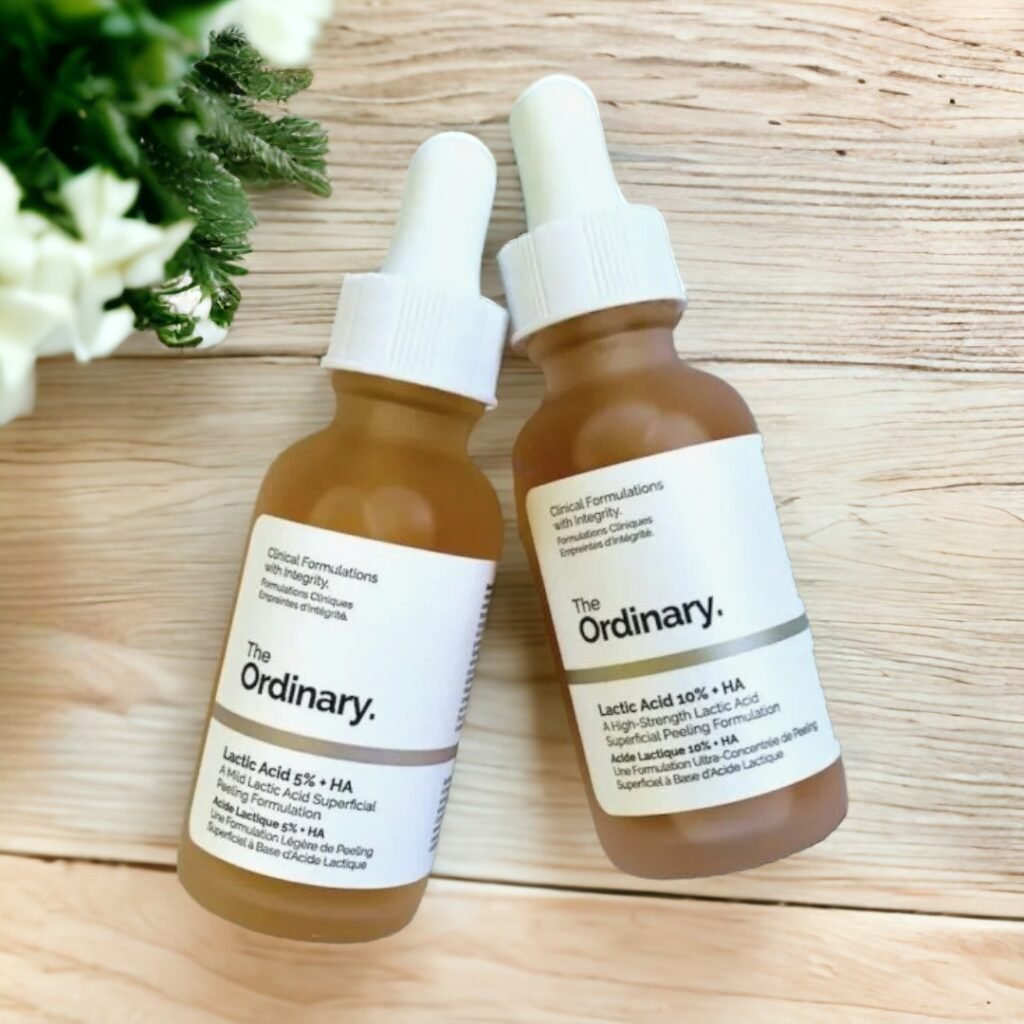Lactic acid is a popular skincare ingredient that can help exfoliate and brighten the skin, leaving it looking more youthful and radiant. The Ordinary, a well-known skincare brand, offers lactic acid products in two concentrations: The Ordinary Lactic Acid 5% + HA and The Ordinary Lactic Acid 10% + HA.
Selecting the right concentration and incorporating these powerful products into your skincare routine can transform the appearance of your skin. Since exfoliating acids can irritate your skin, you should know how to use The Ordinary’s lactic acid serums.
In this guide, I’ll briefly discuss how to use The Ordinary’s lactic acid serums and how to easily mix them into your skincare routine. By following my recommendations, you’ll be well on your way to enjoying the exfoliating and brightening benefits of The Ordinary lactic acid products in your skincare routine. Let’s get started.
What is Lactic Acid

Lactic acid is an alpha hydroxy acid (AHA) that is derived from milk. It is a naturally occurring substance that can be found in various skincare products, including The Ordinary Lactic Acid. This powerful ingredient serves as a chemical exfoliant, providing numerous benefits for the skin.
Lactic acid is known to:
- Gently exfoliate the skin, removing dead skin cells and revealing a brighter, smoother complexion.
- Promote collagen production, improving the skin’s elasticity and reducing the appearance of fine lines and wrinkles.
- Help reduce acne breakouts by unclogging pores and reducing inflammation.
- Improve skin hydration, as it attracts moisture to the skin’s surface.
While lactic acid is generally safe and effective, it is important to use it properly and follow the directions on the product packaging. It is typically best to use lactic acid at night, as it can increase the skin’s sensitivity to sunlight.
Incorporating lactic acid into your skincare routine can offer significant results, leaving your skin feeling radiant and refreshed. However, it’s important to always listen to your skin and adjust your routine as necessary.

The Ordinary Lactic Acid 5% vs 10%

The Ordinary offers two lactic acid products: The Ordinary Lactic Acid 5% + HA and The Ordinary Lactic Acid 10% + HA. Each product contains different concentrations of lactic acid to cater to various skin types, sensitivities, and desired outcomes.
The 5% concentration is suitable for those new to chemical exfoliants or with sensitive skin, while the 10% concentration is recommended for more experienced users or for those with normal to oily skin.
The Ordinary Lactic Acid 10% + HA produces quicker outcomes than its 5% counterpart. However, the pick depends on your skin type and concerns. Both serums look almost the same, except for the slightly darker color of The Ordinary Lactic Acid 10% + HA compared to The Ordinary Lactic Acid 5% + HA.
Both products feature a pH of around 3.8, which strikes a balance between efficacy and skin tolerance. The lower pH enhances the effectiveness of the lactic acid in promoting skin exfoliation and improving overall skin texture.
Lactic acid’s pKa value is 3.86, meaning that in formulations with pH close to its pKa, there will be a balance of the free acid and its inactive salt form. This balance is important to control acid availability in the skin, preventing excessive irritation and ensuring optimum performance.
Both The Ordinary Lactic Acid + HA can provide multiple benefits for your skin, including improved texture and exfoliation.
Benefits of Lactic Acid

Lactic acid, an alpha hydroxy acid (AHA), offers numerous benefits for your skin. Found naturally in sour milk and synthetically produced for skincare products, it acts as a chemical exfoliant to remove dead skin cells from the skin’s surface. This gentle exfoliation can address several skincare concerns, making it a valuable addition to your routine.
One of the primary benefits of lactic acid is its ability to improve acne-prone skin. By exfoliating the top layer of your skin, it helps unclog pores and reduces the buildup of debris that leads to breakouts. Its larger molecule size also ensures that your skin remains moisturized and does not feel stripped, making it suitable for sensitive skin.
In addition to acne treatment, lactic acid plays a significant role in anti-aging. It can improve the appearance of fine lines and wrinkles by promoting cell turnover and encouraging the growth of new, healthier skin cells. This process leaves your skin looking smoother and more youthful.
Lactic acid’s exfoliating properties are not only limited to acne and anti-aging. It also works to improve the overall tone and texture of your skin. By brightening dull skin and reducing dark spots or uneven pigmentation, lactic acid reveals a more even complexion.
Lactic Acid: Suitable For Most Skin Types

Lactic acid is a gentle exfoliant suitable for various skin types, including sensitive and dry skin. This Alpha Hydroxy Acid (AHA) provides numerous benefits, such as smoothing skin texture, brightening the complexion, and reducing fine lines and wrinkles. However, it’s essential to use lactic acid properly, depending on your skin type, to avoid irritation.
Sensitive Skin
For those with sensitive skin, The Ordinary lactic acid is an ideal choice due to its mild nature compared to other AHAs and BHAs. When incorporating lactic acid into your skincare routine, it’s best to start with a low concentration, such as The Ordinary Lactic Acid 5% + HA. Before applying the product, perform a patch test by applying a small amount on a discreet area of your skin (e.g., behind the ear) and observing for any adverse reactions after 24 hours.
Dry Skin
Individuals with dry skin can benefit from lactic acid’s ability to provide gentle exfoliation, revealing healthier and smoother skin. Its humectant properties help retain moisture, preventing further dryness. It is recommended that those with dry skin use a moderate percentage of lactic acid, such as the The Ordinary Lactic Acid 10% + HA. This product offers both exfoliation and hydration.
How to Use The Ordinary’s Lactic Acid for Different Skin Types?
- Start by cleansing your face thoroughly.
- Apply a small amount of lactic acid on your fingertips and gently massage it into your skin. Avoid the eye area.
- Wait for the product to fully absorb into the skin before applying a moisturizer or other skincare products.
- Use sunscreen diligently, as lactic acid can make your skin more sensitive to the sun.
Initially, apply The Ordinary lactic acid once a week to build tolerance. Ensure to monitor your skin’s response, and if no irritation occurs, gradually increase the frequency to two or three times a week, depending on your skin type and needs. Let’s study how to use The Ordinary’s Lactic Acid serums in your skincare routine.
How to Use The Ordinary’s Lactic Acid Serums?

Lactic Acid is an effective and gentle exfoliant, making it a popular choice for many people looking to improve their skincare routine. One of the most popular lactic acid products on the market is The Ordinary’s Lactic Acid serum. This section will guide you through the proper use of this product to help you achieve the best results.
Here’ how to use The Ordinary’s Lactic Acid in your skin care routine:
- Cleanse your face: Before applying the serum, make sure your face is clean and dry.
- Patch test: When using an active serum for the first time, it’s best to do a patch test to ensure you won’t experience any adverse reactions.
- Application: Apply a thin layer of the lactic acid serum to your face in the evening, after using toners but before applying moisturizer.
- Frequency: Start by using the lactic acid serum three times a week, gradually increasing the frequency as your skin builds tolerance. Eventually, you may be able to use it daily.
- When to apply: The correct way to use The Ordinary lactic acid serums is to apply them during the treatment step of your skincare routine. This step should come after cleansing and toning before applying other serums or moisturizers.
While there are various forms of lactic acid available, such as creams and masks, The Ordinary’s Lactic Acid serum offers a more targeted and effective treatment. This serum also contains hyaluronic acid, which helps improve skin hydration by strengthening the lipid barrier.
It’s important to note that certain ingredients may not be compatible with lactic acid. For example, peptides may be less effective when used alongside acidic products. If you’re unsure whether your current skincare products are compatible with The Ordinary’s Lactic Acid, consult a dermatologist for guidance.
Key takeaways of how to use The Ordinary’s Lactic Acid:
- Choose a lactic acid concentration (5% or 10%) based on your skin’s tolerance.
- Apply the serum at night after toners, but before moisturizers.
- Begin by using the serum three times a week and increase frequency as your skin builds tolerance.
- Be cautious when using lactic acid with other ingredients, such as peptides.
Remember, everyone’s skin is different, and results might vary. By following these steps and consulting with a dermatologist, you can safely incorporate The Ordinary’s Lactic Acid into your skincare routine for improved skin texture, tone, and hydration. Now you know how to use The Ordinary’s Lactic Acid Serum, let’s learn about the frequency of use.
How often to use The Ordinary Lactic Acid Serums?
First, decide on a lactic acid concentration: 5% + HA or 10% + HA. If you’re new to acids, try The Ordinary lactic acid serum once a week. Watch how your skin reacts and gradually increase usage as your skin develops a tolerance.
While you can use The Ordinary lactic acid serum daily, most people achieve decent results by taking it twice a week. If feasible, use it in the evening. Please do patch testing before using The Ordinary lactic acid serums or any new product.
What not to combine with The Ordinary Lactic Acid?
Using lactic acid simultaneously with other direct acids, AHAs, or actives like benzoyl peroxide acne treatments is not recommended. Avoid using lactic acid with potent actives like pure vitamin C (ascorbic acid).
The Ordinary lactic acid serums are formulated at a pH that should not compromise the effectiveness of ascorbic acid. However, using both simultaneously may result in redness, stinging, peeling, or irritation. It’s best to use ascorbic acid in the morning and The Ordinary lactic acid in the evening or on different days.
Using retinol and retinoids together with lactic acid may cause irritation and redness since both increase cellular turnover and remove dead skin cells. Additionally, the pH of retinol is higher than acidic lactic acid, so using them together may render both much less effective.
Exfoliation and Lactic Acid
Lactic acid is an alpha hydroxy acid (AHA), which is a type of chemical exfoliant that works by breaking down the bonds between dead skin cells on the surface of the skin. This process allows for the removal of dead cells and encourages cell turnover, resulting in a smoother, brighter complexion.
In comparison, beta hydroxy acids (BHA), like salicylic acid, work more deeply within the pores to unclog them and help reduce acne. While both types of acids can be beneficial for skin exfoliation, lactic acid is more suitable for sensitive or dry skin types, as it’s generally more gentle.
Here are some excellent tips on how to use The Ordinary’s Lactic acid:
- Cleanse your skin: Make sure your face is clean and dry before applying lactic acid.
- Apply the lactic acid: Using your fingertips or a cotton pad, apply a thin layer of the lactic acid solution to your skin. Be careful to avoid the sensitive eye area.
- Wait for it to absorb: Allow the solution to absorb into your skin for a few minutes. You may experience mild tingling, which is normal.
- Moisturize: Follow up with your favorite moisturizer to keep your skin hydrated.

Remember always to wear sunscreen during the day, as AHA can make your skin more sensitive to the sun.
Remember, when incorporating lactic acid into your skincare routine, it’s essential to start slow and follow the product’s instructions. Everyone’s skin is different, so be patient and monitor the results to find the perfect balance for your skin type. And don’t forget to enjoy the benefits of smoother, brighter-looking skin with the help of lactic acid!
Sun Sensitivity and Lactic Acid

Lactic acid is an alpha-hydroxy acid (AHA) that can increase your skin’s sensitivity to the sun, making it more susceptible to sunburn and sun damage. Because of this, it’s essential to take extra precautions when using products containing lactic acid, such as The Ordinary’s Lactic Acid serum.
To protect your skin from sun exposure, it’s crucial to include daily sunscreen use in your skincare routine. Choose a broad-spectrum sunscreen with a minimum SPF of 30, which will shield your skin from both UVA and UVB rays. Make sure to apply the sunscreen generously and reapply every two hours when outdoors, or more frequently if you’re swimming or sweating.
In addition to using sunscreen, consider incorporating other sun protection measures, such as:
- Wearing protective clothing like long sleeves and wide-brimmed hats
- Seeking shade during peak sun hours (usually between 10 AM and 4 PM)
- Wearing sunglasses with UV protection
Since The Ordinary’s Lactic Acid + HA serum is best used at night, you can minimize sun sensitivity risks by including sunscreen in your morning skincare routine. Remember to apply the serum after toners, but before moisturizers, to ensure its effectiveness.
When looking for sunscreen products, you can find a variety of options from reputable beauty brands. A few examples include La Roche-Posay Anthelios Mineral Sunscreen and AM Facial Moisturizing Lotion with Sunscreen.
Incorporating sun protection measures while using The Ordinary’s Lactic Acid serum can significantly reduce the risk of sun sensitivity and ensure the safe and effective exfoliation of your skin.
Wrapping Up
In conclusion, incorporating The Ordinary’s Lactic Acid into your skincare routine can bring about remarkable benefits for your skin. As a gentle yet effective exfoliant, it helps to improve skin texture, reduce hyperpigmentation, and promote a more youthful and radiant complexion. By understanding how to use The Ordinary’s Lactic Acid properly, you can maximize its potential and achieve the desired results.
The Ordinary’s Lactic Acid is a versatile and effective skincare product that can transform your complexion. By understanding how to use it properly and being patient with the process, you can achieve more vibrant, even-toned, and youthful-looking skin.
FAQs
What should I use after The Ordinary Lactic Acid?
After using The Ordinary lactic acid, applying a complementary product to maximize its benefits is essential. For instance, consider using The Ordinary Niacinamide 10% + Zinc 1% to protect your skin’s barrier or The Ordinary Hyaluronic Acid 2% + B5 to keep your skin hydrated.
Can I use The Ordinary Lactic Acid and Niacinamide together?
Yes, you sure can use The Ordinary Lactic Acid serums and water-based niacinamide serums such as The Ordinary Niacinamide 10% + Zinc 1%. It is a good idea to use niacinamide and lactic acid as they offer extra support to the skin barrier.
Can I use The Ordinary Lactic Acid and Vitamin C together?
If you’re considering using The Ordinary Lactic Acid and vitamin C together, it’s essential to be cautious. I recommend avoiding combining direct acids and vitamin C in the same regimen to prevent the risk of developing skin sensitivities. If you want to use both products, separating them into your morning and evening regimens is best.
Can I use The Ordinary Lactic Acid with Hyaluronic Acid?
Yes, using The Ordinary lactic acid serums in combination with The Ordinary Hyaluronic Acid 2% + B5 is possible. These two serums are compatible and can provide multiple benefits to the skin. The hyaluronic acid serum can effectively restore moisture and hydration to the skin, promoting a strong and healthy skin barrier.
Can I use The Ordinary Lactic Acid with Retinol?
No. Using them together is not recommended since the combination can result in redness and irritation. Furthermore, the difference in pH levels between alpha hydroxy acids like retinol and lactic acid may affect the efficacy of the products. It’s best to use The Ordinary lactic acid serums and The Ordinary retinol/retinoids on separate days or at different times.
